 W
WAegirosaurus is an extinct genus of platypterygiine ophthalmosaurid ichthyosaurs known from the late Jurassic and early Cretaceous of Europe. It was originally named as a species of Ichthyosaurus.
 W
WAleosteus eganensis is an extinct arthrodire placoderm fish. Its fossils have been found in the Late Emsian strate of the Sevy Dolomite Formation, in the Egan Range of east-central Nevada, USA. Almost complete fossils belong to juvenile and adult specimens and show a short and broad skull, posteriorly concave.
 W
WAustralobarbarus is a genus of dicynodont from Late Permian (Wuchiapingian) of Russia.
 W
WBambiraptor is a Late Cretaceous, 72-million-year-old, bird-like dromaeosaurid theropod dinosaur described by scientists at the University of Kansas, Yale University, and the University of New Orleans.
 W
WBroomistega is an extinct genus of temnospondyl amphibian in the family Rhinesuchidae. It is known from one species, Broomistega putterilli, which was named in 2000. Fossils are known from the Early Triassic Lystrosaurus Assemblage Zone of the Beaufort Group in the Karoo Basin of present-day South Africa, a region that had been an enclave of Gondwana. Specimens of B. putterilli were once thought to represent young individuals of another larger rhinesuchid such as Uranocentrodon, but the species is now regarded as a paedomorphic taxon, possessing the features of juvenile rhinesuchids into adulthood.
 W
WByronosaurus is a genus of troodontid dinosaur from the Late Cretaceous Period of Mongolia.
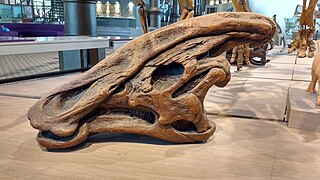 W
WCharonosaurus is the name of a genus of dinosaur whose fossils were discovered by Godefroit, Zan & Jin in 2000 on the south bank of the Amur River, dividing China from Russia.
 W
WChuanjiesaurus is a genus of sauropod dinosaurs from the middle Jurassic Period. They lived in what is now China. The type species, Chuanjiesaurus anaensis, was first described by Fang, Pang, Lü, Zhang, Pan, Wang, Li and Cheng in 2000. Fossils of the species were found in the village of Chuanjie, Lufeng County, Yunnan Province, and are named after the location where the fossils were discovered. Holtz gave a length of 25 meters.
 W
WDadadon is an extinct genus of traversodontid cynodonts which existed in Madagascar during the late Middle Triassic. The only species in the genus is Dadadon isaloi.
 W
WDadadon is an extinct genus of traversodontid cynodonts which existed in Madagascar during the late Middle Triassic. The only species in the genus is Dadadon isaloi.
 W
WDebeerius is a genus of chondrichthyan from the Mississippian age Bear Gulch Limestone of Montana, United States. Its generic name honours Sir Gavin de Beer.
 W
WDow's puffin is an extinct seabird in the auk family described in 2000 from subfossil remains found in the Channel Islands of California.
 W
WDromotectum is an extinct genus of bystrowianid reptiliomorph from the Late Permian of China and Early Triassic of Russia. Two species have been named: the type species D. spinosum and the species D. largum. D. spinosum, the first species to be named, comes from Lower Triassic deposits in the Samara Region of European Russia and is known from the holotype PIN 2424/23, which consists of armor scutes, and from PIN 2424/65, 4495/14 and 2252/397. It was found in the Staritskaya Formation of the Rybinskin Horizon and named by I.V. Novikov and M.A. Shishkin in 2000. The generic name means “corridor with hipped vault” + “roof” (tecton), and the specific name means “spinous”. A second species, D. largum, was named by Liu Jun, Xu Li, Jia Song-Hai, Pu Han-Yong, and Liu Xiao-Ling in 2014 from the Shangshihezi Formation near Jiyuan in Henan province, China on the basis of specimen IVPP V 4013.1, a large scute.
 W
WEocoracias is an extinct genus of bird related to modern rollers and other Coraciiformes such as kingfishers, bee-eaters, motmots, and todies. It contains one species, Eocoracias brachyptera, and it lived approximately 47 million years ago based on dating of the fossil site. It is known for a specimen having preserved non-iridescent structural coloration on its feathers, previously unknown in fossil birds. Fossils have been found at the Messel Pit in Germany.
 W
WEudibamus is an extinct genus of biped bolosaurid ankyramorph parareptile known from the Free State of Thuringia of central Germany. It had a very small size reaching only 25 cm in length.
 W
WFukuiraptor was a medium-sized megaraptoran theropod dinosaur of the Early Cretaceous epoch that lived in what is now Japan.
 W
WGodinotia is an extinct genus of strepsirrhine primate belonging to the Adapidae family. It lived during the Eocene epoch, and its fossils have been found in the Messel Pit, Germany.
 W
WGraciliceratops is a genus of neoceratopsian dinosaurs that lived in Asia during the Late Cretaceous period.
 W
WHuabeisaurus was a genus of dinosaur from the Late Cretaceous. It was a sauropod which lived in what is present-day northern China. The type species, Huabeisaurus allocotus, was first described by Pang Qiqing and Cheng Zhengwu in 2000. Huabeisaurus is known from numerous remains found in the 1990s, which include teeth, partial limbs and vertebrae. Due to its relative completeness, Huabeisaurus represents a significant taxon for understanding sauropod evolution in Asia. Huabeisaurus comes from Kangdailiang and Houyu, Zhaojiagou Town, Tianzhen County, Shanxi province, China. The holotype was found in the unnamed upper member of the Huiquanpu Formation, which is Late Cretaceous (?Cenomanian–?Campanian) in age based on ostracods, charophytes, and fission-track dating.
 W
WIsanosaurus was a sauropod dinosaur from Thailand. It was originally dated to approximately 210 million years ago during the Late Triassic, which would make it one of the oldest known sauropods. Its age was later considered uncertain, and may be as young as Late Jurassic. The only species is Isanosaurus attavipachi. Though important for the understanding of sauropod origin and early evolution, Isanosaurus is poorly known. Exact relationships to other early sauropods remain unresolved.
 W
WJeholosaurus is a genus of ornithischian dinosaur from the Early Cretaceous Period. It is thought to have been a herbivorous small ornithopod.
 W
WKutchicetus is an extinct genus of early whale of the family Remingtonocetidae that lived during Early-Middle Eocene in what is now the coastal border of Pakistan and India. It is closely related to Andrewsiphius with which it was synonymized by Gingerich et al. 2001. Thewissen & Bajpai 2009 proposed a new clade, Andrewsiphiinae, for the two species. Later authors, however, still accept both as separate genera.
 W
WMicroraptor is a genus of small, four-winged paravian dinosaurs. Numerous well-preserved fossil specimens have been recovered from Liaoning, China. They date from the early Cretaceous Jiufotang Formation, 120 million years ago. Three species have been named, though further study has suggested that all of them represent variation in a single species, which is properly called M. zhaoianus. Cryptovolans, initially described as another four-winged dinosaur, is usually considered to be a synonym of Microraptor.
 W
WNanolania is an extinct genus of rhytidosteid temnospondyl from the early Triassic period of south central Queensland, Australia. It is known from the holotype QMF 12293, a postorbital fragment associated with lower jaw fragments and from the associated paratypes QMF 14480, a laterally complete skull with mandibles, QMF 35247, a poorly preserved skull with right mandibular ramus, QMF 35393, a badly preserved partial skull and QMF 39666, a posterior orbital and mandibular fragment, recovered from the Arcadia Formation in the Rewan Group. This genus was named by Adam M. Yates in 2000, and the type species is Nanolania anatopretia.
 W
WNanyangosaurus is a genus of herbivorous ornithischian dinosaur belonging to Hadrosauroidea that lived in the Late Cretaceous of present-day Henan Province, China.
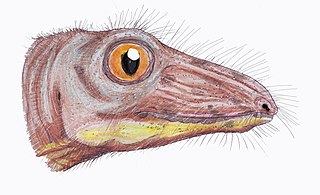 W
WNikkasaurus is an extinct genus of therapsids.
 W
WNomingia is a genus of oviraptorid theropod dinosaur hailing from the Late Cretaceous Bugin Tsav Beds of Mongolia.
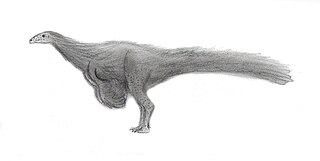 W
WNqwebasaurus is a basal coelurosaur and is the basal-most member of the coelurosaurian clade Ornithomimosauria from the Early Cretaceous of South Africa. The name Nqwebasaurus is derived from the Xhosa word "Nqweba" which is the local name for the Kirkwood district, and "thwazi" is ancient Xhosa for lightning. Currently it is the only named coelurosaur discovered in Africa and shows that basal coelurosaurian dinosaurs inhabited Gondwana 50 million years earlier than previously thought. The type specimen of Nqwebasaurus was discovered by William J. de Klerk who is affiliated with the Albany Museum in Grahamstown. It is the only fossil of its species found to date and was found in the Kirkwood Formation of the Uitenhage Group. Nqwebasaurus has the unofficial nickname "Kirky", due to being found in the Kirkwood.
 W
WOffacolus is an extinct genus of euchelicerate, a group of chelicerate arthropods. Its only species, O. kingi, has been found in deposits from the Silurian period in the Wenlock Series Lagerstätte of Herefordshire, England. It is classified as a basal ("primitive") genus in the monotypic family Offacolidae in the clade Euchelicerata, along with Dibasterium and Prosomapoda. The genus is named after Offa, a king from the ancient kingdom of Mercia, and colus, a person who dwelled among the Offa's Dyke. The species name honors Robert Joseph King, a British mineralogist who found the fossils of Offacolus.
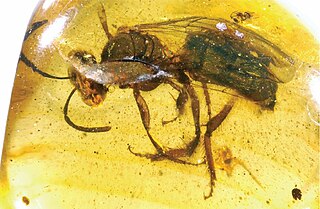 W
WOligochlora is an extinct genus of sweat bee in the Halictidae subfamily Halictinae. The genus currently contains six species, all of which are known from the early Miocene Burdigalian stage Dominican amber deposits on the island of Hispaniola.
 W
WPohlsepia mazonensis is the earliest described octopod, originating from the late Carboniferous period. The species is known from a single exceptionally preserved fossil discovered in the Pennsylvanian Francis Creek Shale of the Carbondale Formation, north-east Illinois, United States.
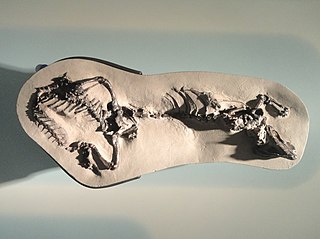 W
WPolyglyphanodontia is an extinct clade of lizards from the Cretaceous that includes around a dozen genera. Polyglyphanodontians were the dominant group of lizards in North America and Asia during the Late Cretaceous. Most polyglyphanodontians are Late Cretaceous in age, though the oldest one, Kuwajimalla kagaensis, is known from the Early Cretaceous Kuwajima Formation (Japan). Early Cretaceous South American taxon Tijubina, and possibly also Olindalacerta, might also fall within Polyglyphanodontia or be closely allied to the group, but if so, they would be two of only three Gondwanan examples of an otherwise Laurasian clade. They produced a remarkable range of forms. Chamopsiids, including Chamops, were characterized by large, blunt, crushing teeth, and were most likely omnivores. Macrocephalosaurus, from the Gobi Desert, was a specialized herbivore; it grew to roughly a meter long and had multicusped, leaf-shaped teeth like those of modern iguanas. Polyglyphanodon, from the Maastrichtian of Utah, was another herbivore, but its teeth formed a series of transverse blades, similar to those of Trilophosaurus. Peneteius had remarkable, multicusped teeth, similar to those of mammals. The polyglyphanodontids first appear in the latter part of the Early Cretaceous in North America, and became extinct during the Cretaceous-Paleogene extinction event. Polyglyphanodontians closely resembled the teiid lizards, and purported teiid lizards from the Late Cretaceous appear to be polyglyphanodontians. The only species known to have survived the Cretaceous was Chamops, which survived until the very early Ypresian.
 W
WPonerosteus is a dubious genus of archosauromorph which was first identified as "Iguanodon exogirarum" by Antonín Frič in 1878 for a specimen from the Cenomanian. He later (1905) renamed it Procerosaurus, unaware that this name was already in use. It was renamed Ponerosteus exogyrarum by George Olshevsky in 2000; however, the taxon is considered a nomen dubium by most, as the type material is extremely poor, being apparently an internal cast of a tibia from an animal that may or may not be a dinosaur. The name Ponerosteus can be translated as "bad", "worthless", or "useless bone", which accurately describes the nature of the material.
 W
WPrionomyrmex is an extinct genus of bulldog ants in the subfamily Myrmeciinae of the family Formicidae. It was first described by Gustav Mayr in 1868, after he collected a holotype worker of P. longiceps in Baltic amber. Three species are currently described, characterised by their long mandibles, slender bodies and large size. These ants are known from the Eocene and Late Oligocene, with fossil specimens only found around Europe. It is suggested that these ants preferred to live in jungles, with one species assumed to be an arboreal nesting species. These ants had a powerful stinger that was used to subdue prey. In 2000, it was suggested by Cesare Baroni Urbani that the living species Nothomyrmecia macrops and a species he described both belonged to Prionomyrmex, but this proposal has not been widely accepted by the entomological community. Instead, scientists still classify the two genera distinctive from each other, making Nothomyrmecia a valid genus.
 W
WPyroraptor is a genus of dromaeosaurid dinosaur from the Late Cretaceous of what is now southern France and northern Spain, it lived during the late Campanian and early Maastrichtian stages, approximately 70.6 million years ago. It is known from a single partial specimen that was found in Provence in 1992. The animal was named Pyroraptor olympius by Allain and Taquet in 2000.
 W
WRepenomamus is a genus of opossum-sized to badger-sized gobiconodontid mammal containing two species, Repenomamus robustus and Repenomamus giganticus. Both species are known from fossils found in China that date to the early Cretaceous period, about 125-123.2 million years ago. R. robustus is one of several Mesozoic mammals for which there is good evidence that it fed on vertebrates, including dinosaurs, though it is not possible to determine if it actively hunted live dinosaurs or scavenged dead ones. R. giganticus is among the largest mammals known from the Mesozoic era.
 W
WRheodytes devisi is a Pleistocene fossil turtle from the Darling Downs of Queensland, Australia. It was described from material originally included in the description of Elseya uberima.
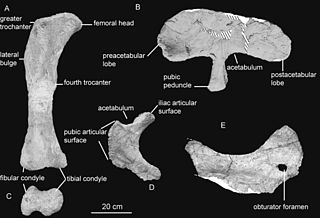 W
WRocasaurus is a genus of titanosaurian sauropod that lived in South America. Rocasaurus was discovered in Argentina in 2000, within the Allen Formation which is dated to be middle Campanian to early Maastrichtian in age. This genus grew up to 8 metres (26 ft) long, making it one of the smaller sauropods. It seems to be closely related to saltasaurid dinosaurs, like Saltasaurus and Neuquensaurus.
 W
WSauroposeidon is a genus of sauropod dinosaur known from several incomplete specimens including a bone bed and fossilized trackways that have been found in the American states of Oklahoma, Wyoming, and Texas.
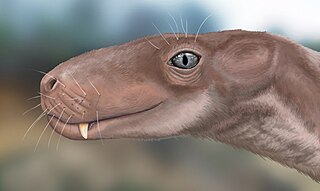 W
WScalopodontes is an extinct genus of therocephalian which existed in Russia during the Late Permian period. The type species is Scalopodontes kotelnichi. Fossils have been found in the Sokolki Assemblage Zone of the Urpalov Formation.
 W
WSinocyamodus is an extinct genus of placodont reptile from the Late Triassic (Tuvalian) Xiaowa Formation of China. Only one species, Sinocyamodus xinpuensis, is currently assigned to this genus. This genus was the first placodont to be discovered in the eastern Tethys, overthrowing traditional views that the group was restricted to the western Tethys.
 W
WSorbinichthys is an extinct genus of clupeomorph bony fish from the Cenomanian of Lebanon and Morocco.
 W
WVigilius is an extinct genus of brachyopid temnospondyl amphibian from the Triassic of Arizona. It is known from the single type species Vigilius wellesi.
 W
WXenosmilus hodsonae is an extinct species of the Machairodontinae, or saber-toothed cats. The species name hodsonae originates from Debra Hodson, the wife of a researcher. Two fairly intact specimens were found by amateur fossil hunters in 1983 in the Haile limestone mines in Alachua County, Florida. In 1994, the fossils were examined, and it was decided that the cats were of an entirely new genus. The fossils were of Irvingtonian age. Because the skeletons were found beside each other, some suspect Xenosmilus was a social mammal. Found alongside the two skeletons were dozens of peccary bones. It seems likely, with their muscular builds, that X. hodsonae preyed upon peccaries. It has also been theorized by some to have hunted via a "bite and retreat" strategy using its teeth to inflict deep wounds because of the way its canines and incisors could operate as a unit during a bite, leading to Xenosmilus bearing the occasional moniker of "cookie-cutter cat".
 W
WZiphosuchia is a clade of mesoeucrocodylian crocodyliforms that includes notosuchians and sebecosuchia